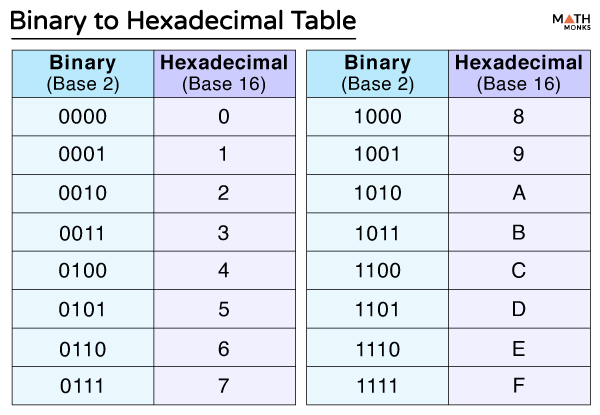
convert hex to letters
Unlocking the Secrets: Converting Hex to Letters
Ever felt like you're staring at a jumble of numbers and letters, a code whispering secrets? Hexadecimal, often a headache, isn't really so mysterious. We can crack the code together.
What is Hexadecimal?

Source: learnmeabitcoin.com
Hexadecimal (or "hex" for short) is a way of representing numbers. Unlike the normal decimal system we use daily (0-9), hex uses 16 digits. These digits include 0-9 and A-F, with A representing 10, B representing 11, and so on, all the way to F representing 15. (It's like having extra letters in the alphabet, just for numbers.)
Why Use Hex?

Source: mathmonks.com
Hex is super common in computer science and web design. It's useful because computers deal in 0s and 1s; hex is easier for us to read and use. It represents binary information more concisely.
Understanding the Decimal to Hex Conversion
To grasp hex, start with the fundamentals. This helps visualize. Imagine these number groups like friends, sticking together in the same group.
Example: Decimal 255
- Step 1: Divide by 16: Divide your decimal number by 16. (255 / 16 = 15 with a remainder of 15)
- Step 2: The Remainder is Crucial: Note down that remainder (15), that is part of the hexadecimal representation, think of this as the final answer. This becomes part of your hex.
- Step 3: The Quotient: Now, focus on the quotient (the part that came before the remainder), divide it again by 16: (15 / 16 = 0 with a remainder of 15) (In this case, since it's zero, the journey ends right here! (Hooray!)
- Step 4: Reading Upwards (from bottom to top) = FF: Assemble your answers. Remember to keep working up!
From remainder to quotient. Starting with last one. For 255 (decimal), the equivalent hexadecimal is FF.
Hex to Letter Conversion: Straightforward!
Think of each hex digit (either a number 0 to 9, or A to F) representing an equivalent value, converting that into letters according to their numeric representations is actually rather easy once you understand hex values:
- Identify the hex: Check the hex value (FF) or any other hexadecimal
- Mapping: Each hex symbol from 0 to 9 is a digit representing it, and the capital letters represent values. A = 10, B = 11… up to F=15 ( remember 0 = zero)
- The magic trick is: Mapping each number digit in Hex to their value equivalents. For example, 0 stays as zero, 1 stay as one, 2 as two, up to 9 = 9 and, A maps to 10, B to 11 etc., up to F =15
- Now you get letters. Once you map those letters or digits using mapping above you are done with letter conversions, converting to letter(s) from these conversions is as easy as simple mapping now.
Why Is Hex Useful in the Real World?

Source: ytimg.com
- Color codes (web design) : Websites use hex to describe colors (e.g., #FF0000 for red). Each set of 2 digits in the hex codes represent colors such as red, green, and blue respectively
- Computer memory : Computers use hexadecimal for addressing different places. Memory spaces are all based on hex codes.

Source: finalsitesupport.com
Real-World Examples
Think of RGB color values, these values follow the principle, of conversion process in hexadecimal, this directly relates to the process you will be performing and to find the mapping between numbers and the letter conversions
Challenges in Hex Conversions
A possible pitfall people encounter is not correctly translating hex numbers (0-9, and A-F).
Common Issues and Fixes
If you're facing problems with the conversion process.
Tools
Many online tools can help with converting between hexadecimal, decimal, binary, and more. A quick online search can guide you.
Summary Table: Conversion Steps for 255
<table>
Other common examples.
- Decimal 216: Hex is D8 (easy process of converting). The conversion from Decimal to hexadecimal follows exactly the same principle of repeatedly dividing by 16 and tracking remainders (which represents the hexadecimal values) to the last number is 8(reminder) to the next to last number D representing 13, this sequence and numbers will help in determining the hexadecimal equivalent value (Decimal).
- Decimal 14: Hex is E(remember the table earlier mapping hex A = 10, B =11).
(Do some exercises yourself.) These practices help solidify the concept of conversion processes, and help strengthen memory about what the hex number actually means).
Frequently Asked Questions (FAQs)
Q: What if I have a very big number?
A: The process remains the same, you keep dividing and tracking remainders! Just need to work through, until the final remainder(division step) result in zero (0) to reach the end, following the process.
Q: Can I convert other systems as well?
A: Yes. Octal (base 8), and binary (base 2) are a couple of them. Learning those could be beneficial for understanding number systems (more specifically, their conversions to decimal, to understand number systems further.).
Conclusion
Hexadecimal isn't a foreign language, but a different numbering system. This different numbering system enables concise representations for computer values. Converting between different numerical systems is rather intuitive and once you understand how these systems are mapped into each other (from Hex to Decimal or other bases vice-versa), converting is actually easy to learn, rather than sounding scary at first, right.


